Context
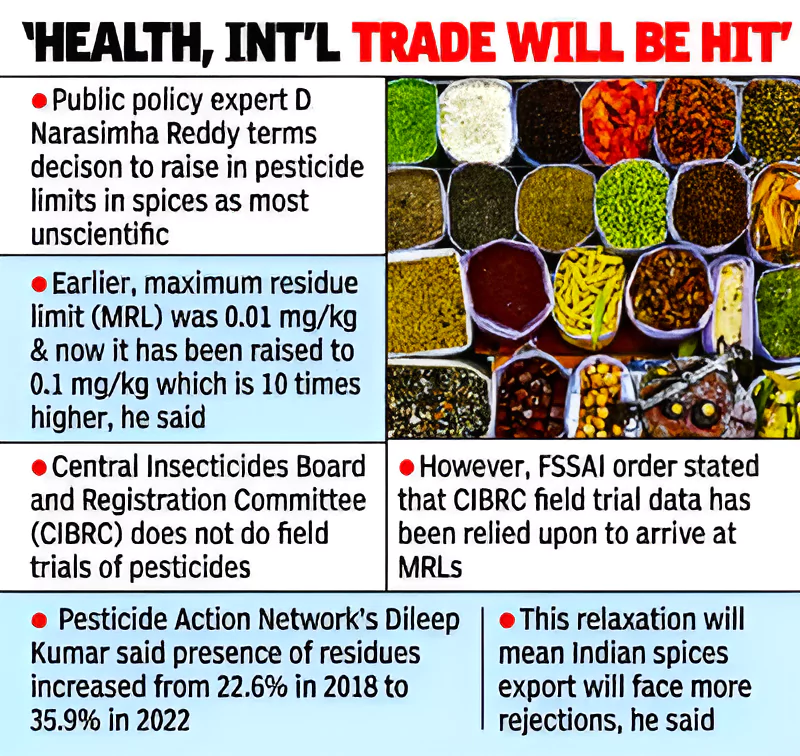
Recently, the Food Safety and Standards Authority of India (FSSAI) said that India has one of the most stringent standards of maximum residue limits (MRLs) in the world and rejected reports suggesting that food regulator FSSAI allows high levels of residues in spices and herbs.
FSSAI denies claims of high pesticide in Indian herbs, spices
- Reason for Such Clarification: It comes amid a ban imposed by the Hong Kong food regulator on certain spice mix of two leading Indian brands MDH and Everest on alleged presence of pesticide Ethylene Oxide in their samples.
-
- Ethylene oxide is a cancer-causing agent which raises the risk of breast cancer and lymphoma.
- The Singapore food regulator ordered a recall of one spice product of the Everest brand.
- Also, the European Union’s food safety authorities flagged the presence of cancer-causing chemicals in 527 food products originating from India.
Enroll now for UPSC Online Course
About Pesticides
A pesticide is any substance or mixture of substances intended for preventing, destroying, or controlling any pest.
- Classification:
- On the basis of Chemical Classes:
- Organic Pesticides: They are usually considered as those pesticides that come from natural sources. These natural sources are usually plants, as in the case of pyrethrum, rotenone, or ryania (botanical insecticides).
- They are classified according to their chemical structure, such as chlorohydrocarbon, insecticides, organophosphorus insecticides, etc
- Inorganic Pesticides: They do not contain carbon elements in their chemical structure. They are typically derived from mineral ores extracted from the earth.
- It includes copper sulfate, ferrous sulfate, copper, lime, and sulfur.
- On the basis of Different Targets of Pests:
- Fungicides: Fungi,
- Insecticides: Insects,
- Herbicides: Plants, and
- Rodenticides: Rodent (mice and rats)
- Registration: Pesticides in India are registered with the Directorate of Plant Protection, Quarantine & Storage, an attached office under the Ministry of Agriculture & Farmers Welfare.
Status of Pesticides In India
- In Production: India is the fourth largest global producer of agrochemicals after the U.S., Japan, and China.
- Agrochemicals: These are chemical products composed of fertilizers, plant-protection chemicals or pesticides, and plant-growth hormones used in agriculture.
|
-
- The pesticide market size in India is estimated to be ₹229.4 billion in 2022, and it is expected to reach ₹342.3 billion by 2028, with a projected Compounded Annual Growth Rate (CAGR) of 4.6% to 4.08%.
- Favorable Factors:
- Low manufacturing cost, low labor cost, technically trained manpower, and high production capacity.
- In Export: According to the WTO, India has emerged as the second largest exporter of agrochemicals in the world, which was sixth 10 years back.
- In the financial year 2022-23, agrochemical exports from India reached US$ 5.4 Billion (Rs. 43,223 crores), up from US$4.9 billion (Rs.36,521 crores) in financial year 2021-2022.
- The U.S. is the largest buyer of India-made agrochemicals, followed by Brazil and Japan.
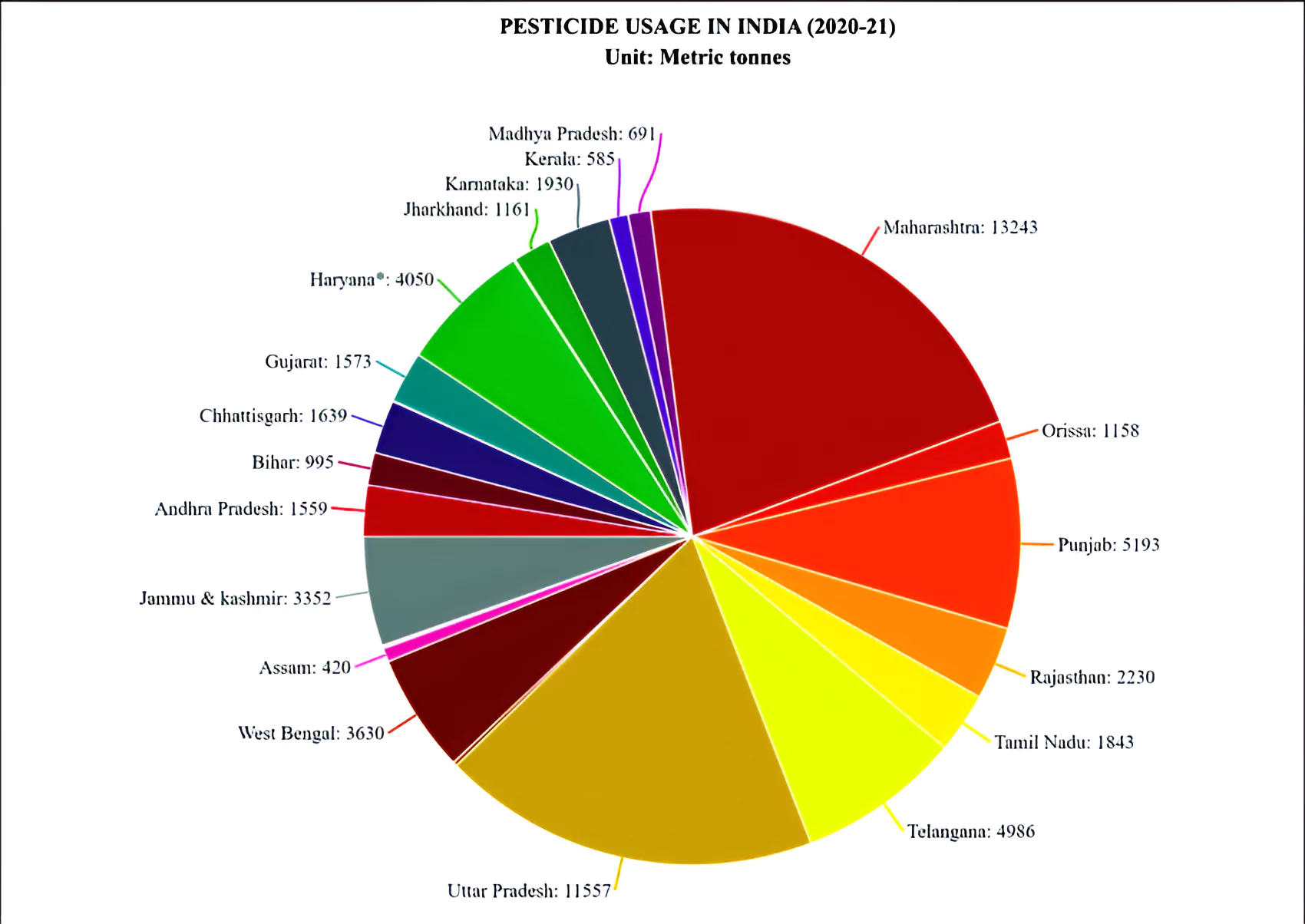 States Consuming Most Pesticides: Maharashtra has consumed the most chemical pesticides in India in the past five years, followed by Uttar Pradesh, Punjab and Haryana.
States Consuming Most Pesticides: Maharashtra has consumed the most chemical pesticides in India in the past five years, followed by Uttar Pradesh, Punjab and Haryana.- In Usage: According to FAO, India used over 61,000 tonnes of pesticides in 2020, which is relatively lower than that of Brazil, China, and Argentina.
- Currently, 104 pesticides are being manufactured in India among 293 registered pesticides.
- Beginning of Production & Usage in India: The Green Revolution during the mid 1960s led to the use of yield-increasing inputs such as High Yield Variety (HYV) seeds, chemical fertilizers and pesticides, which significantly increased the production of food grains and other crops too.
About Pesticides Regulation in India
Pesticides are regulated under the Insecticides Act, 1968 and the Insecticides Rules, 1971.
-
- Insecticides Act, 1968: The Insecticides Act of 1968 covers the registration, manufacture and sale of pesticides in India.
- It was brought with a view of regulating the import, manufacturing, sale, transport, distribution, and use of insecticides and pesticides to prevent the risk to human beings and animals.
- Establishment of the Central Insecticides Board: It was established under Section 4 of the Act and it works under the Ministry of Agriculture and Farmers’ Welfare.
- Mandate: The Central Insecticides Board advises the central government and state governments on technical matters arising out of the administration of the act and to carry out the other functions assigned to it.
- Data Examination: The Scientific Panel on Pesticides Residues of FSSAI examines the data received through Central Insecticide Board and Registration Committee (CIB & RC) and recommends the Maximum Residue Limits (MRLs) after performing risk assessment considering the dietary consumption of the Indian population and health concerns in respect of all age groups.
- The total pesticides registered by CIB & RC in India are more than 295, of which 139 pesticides are registered for use in spices.
Enroll now for UPSC Online Classes
The Pesticides Management Bill, 2020
- Central Pesticides Board: The Central Government will constitute the Central Pesticides Board to advise the central and state governments on scientific and technical matters arising under the act.
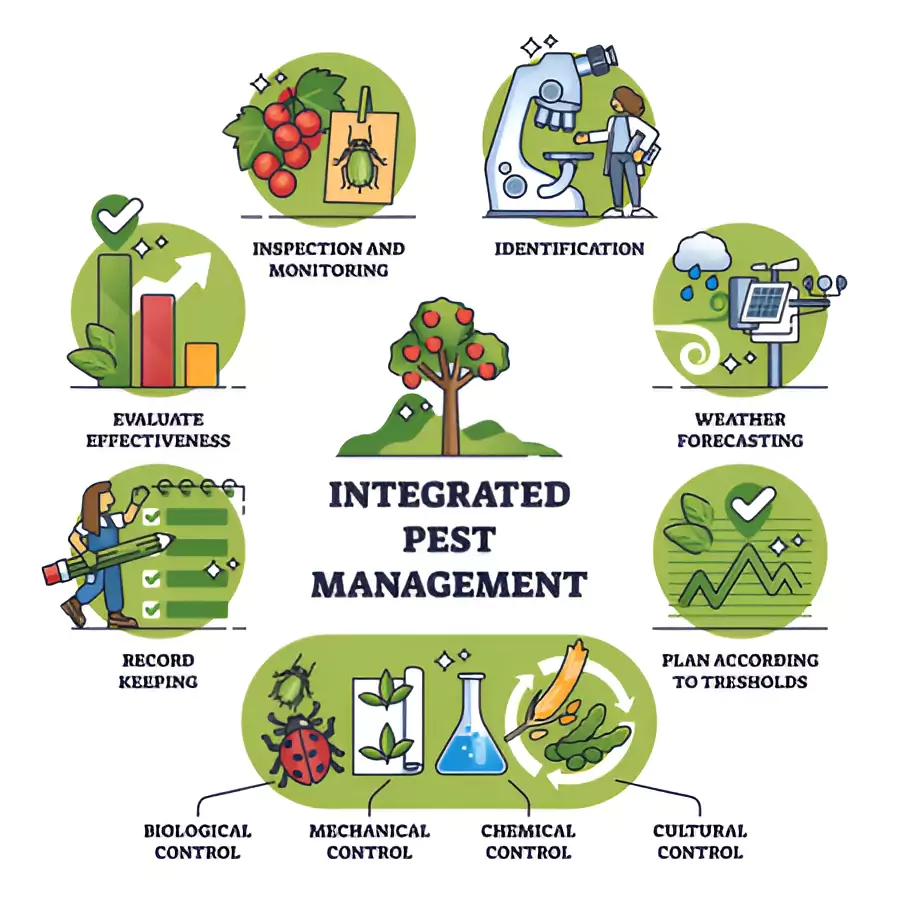 Registration of Pesticides: Persons seeking to import or manufacture a pesticide for ordinary use, agriculture, industry, pest control, or public health are required to obtain a certificate of registration for the pesticide. Registration of Pesticides: Persons seeking to import or manufacture a pesticide for ordinary use, agriculture, industry, pest control, or public health are required to obtain a certificate of registration for the pesticide.- Licences: A person seeking to manufacture, distribute, exhibit for sale, stock pesticides, or undertake pest control operations is required to obtain a licence from the Licensing officer, who the State government may appoint.
- Offences: Under the bill, manufacturing, importing, transporting, storing, etc without a licence or certificate is punishable with imprisonment of up to three years, a fine of up to Rs 40 lakh, or both.
Integrated Pest Management (IPM) Programme
- To reduce use of pesticides, the IPM programme was introduced in 1992 which combines the use of biological, cultural and chemical practices to control insect pests in agricultural production.
|
About Maximum Residue Limits (MRLs)
- Refers: MRL is the maximum amount of pesticide residue expected to remain on food products when a pesticide is used according to label directions and is not a health concern for humans.
- Standards Set by: FSSAI aligns with the updated standards of MRLs set by Codex Alimentarius Commission and International Food Safety and Quality Standard setting body created by WHO and FAO of UN and the European Union.
- Classification: This practice is aligned with global standards and ensures that MRL revisions are made on a scientifically valid basis, reflecting the latest findings and international norms.
- MRLs are fixed at different levels for different food commodities based on risk assessments.
- The MRLs are dynamic and regularly revised based on scientific data.
|
About Global Pesticides Regulation
- The Codex Alimentarius Commission on Pesticide Residues: It is an international body that has adopted 243 pesticides, of which 75 are applicable for spices.
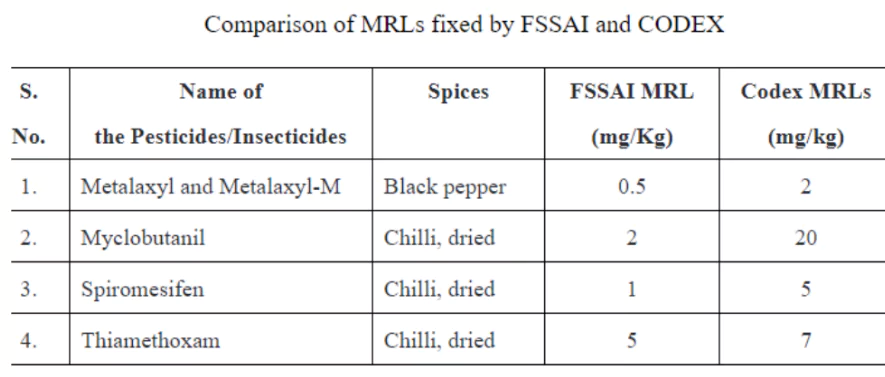 The Codex Alimentarius is a collection of internationally recognized standards, codes of practice, guidelines, and other recommendations published by the Food and Agriculture Organization relating to food, its production, labeling, and safety.
The Codex Alimentarius is a collection of internationally recognized standards, codes of practice, guidelines, and other recommendations published by the Food and Agriculture Organization relating to food, its production, labeling, and safety.
- Mandate: The Codex panel has been set up to develop food standards under the Joint FAO/WHO Food Standards Programme.
- Accepted MRLs: There are different maximum residue limits of pesticides allowed for many food commodities based on risk assessment data.
- Example: The use of pesticide monocrotophos is allowed on many crops with different MRLs such as rice at 0.03mg/kg, citrus fruits at 0.2mg/kg, coffee beans at 0.1 mg/kg and cardamom 0.5mg/kg, chilli at 0.2mg/kg.
- The FSSAI has clarified that MRL of 0.01mg/kg was applicable in case of pesticides for which MRLs have not been fixed. This limit was increased to 0.1mg/kg only in cases of spices and is applicable only for those pesticides which are not registered in India by CIB & RC.
- Refers: It is the national association representing the Indian agrochemical industry with 221 large, medium, and small-scale industries as its members, and has played a crucial role in the growth of the Indian agrochemical sector.
- Significance: PMFAI has played an important role in promoting exports of agrochemicals from India by organizing International Crop Science Conference & Exhibitions (ICSCE) in various countries since 1997.
- PMFAI first organized ICSCE in 1997 in Mumbai.
About FSSAI (Food Safety and Standards Authority of India)
FSSAI has been established under Food Safety and Standards, 2006 which consolidates various acts & orders that have hitherto handled food related issues in various Ministries and Departments.
- Nodal Ministry: Ministry of Health & Family Welfare
- Functions:
-
- Framing of Regulations to lay down the Standards and guidelines in relation to articles of food and specifying appropriate systems of enforcing various standards thus notified.
- Laying down mechanisms and guidelines for accreditation of certification bodies engaged in certification of food safety management systems for food businesses.
- Laying down procedure and guidelines for accreditation of laboratories and notification of the accredited laboratories.
-
Governance of FSSAI:
- The FSSAI consists of a Chairperson and twenty-two members, with one-third of the members being women.
- The Chairperson of FSSAI is appointed by the Central Government.
- It is assisted by Scientific Committees and Panels in setting standards and the Central Advisory Committee in coordinating with enforcement agencies.
|
Benefits of Pesticides
- Boost Yield: By minimizing crop losses, pesticides enable farmers to produce more food on the same amount of land, contributing to global food security and affordability.
- About one-third of agricultural products are produced using pesticides.
- Without the use of pesticides, there would be a 78% loss of fruit production, a 54% loss of vegetable production, and a 32% loss of cereal production.
- Enhance Farmer Income and Guarantee Food Security:
- Doubling Farmers Income: India has set a goal to double farmer’s income.
Enroll now for UPSC Online Course
- 24 pesticides registered and used in India: Acephate, Alachlor, Atrazine, Benomyl, Bifenthrin, Captan, Chlorothalonil, Cypermethrin, Dichlorvos, Diclofop-Methyl, Dicofol, Mancozeb, Methomyl, Metolachlor, Oxadiazon, Oxyfluorfen, Permethrin, Phosphamidon, Propiconazole, Propoxur, Thiodicarb, Thiophanate Methyl, Triadimefon and Trifluralin
|
-
-
- Higher incomes are a function of two factors, higher yields and lower costs which can be possible by the use of these 24 pesticides.
- Improved Crop Quality: By controlling pests that blemish or damage crops, they can help maintain higher quality produce, allowing farmers to command better prices for their crops in the market.
- Reduction in Losses: Pests can significantly damage crops which can be minimized with pesticides and a larger portion of the harvest will reach the market contributing to farmers’ income.
- Insect pests can create crop damage between 20-30% including grains stored in the warehouse.
- Increased Efficiency: By controlling weeds and other pests, they can reduce the need for manual labor in tasks like weeding and pest control. This can not only improve efficiency but also save farmers time and money.
- Expand the Scope of Export Potential:
-
- Agri Export Targets: Agriculture accounts for 14% of merchandise exports and the value of India’s agricultural exports was $52 billion in the year 2022-23 according to the Commerce Ministry.
- The ministry has set a target for commodities exports to cross $100 billion.
- Overcoming Export Challenges: To promote agriculture exports the government has already placed curbs on exports of wheat and rice and tightened restrictions on sugar and onion exports.
- According to the Commerce Ministry’s estimates, the continuity of the pesticides will ensure Rs. 10,000 crores of exports.
Challenges with Pesticides
- Regulatory Concerns: Agriculture is a state subject, however its production, education and research are governed under the Insecticides Act, 1968, a central Act, and hence state governments have no direct role in amending it.
- International Market Dynamics: Exports from India, comprising 55% to the Latin America and United States markets, may face challenges in the immediate term, with struggles likely to persist until the November cropping season.
- The threat of potential dumping from China is large, as they continue to increase pesticide manufacturing capacities. If they look to lower prices to expand their market share in India, local markets can potentially be disrupted substantially.
- Increased Risk to Human Health: Inappropriate use of pesticides may lead to increased risks to human health and the environment.
- Farmers: They are exposed to pesticide-contaminated soils via different pathways such as dermal contact, direct ingestion, and inhalation.
- Biomagnification is the process by which a pollutant or pesticide increases its concentration in organisms as it passes up the food chain.
|
-
- Consumers: Pesticides go up the food chain by working their way through the environment and into the soil or the water systems after which they are eaten by aquatic animals or plants and ultimately humans (the process is known as Biomagnification).
- The most widely known organochlorine pesticide has been associated with health effects, such as endocrine disorders, lipid metabolism etc.
- Soil Degradation: They can also harm the microorganisms that live in soil, which are essential for solid health leading to decreased fertility and erosion.
- From 1990 to 2018, there have been registered amounts of used pesticides by all countries, especially in Asia and America.
- The world average quantity has increased from 1.55 kg per hectare in 1990 to 2.36 kg per hectare.
- Agriculture: Continued use of pesticides for decades has impacted the Indian agriculture sector and its production.
- Pesticide Runoff: When pesticides are applied to crops, some of them can wash off the plants and into the soil and water. This can contaminate surface water, groundwater and even drinking water supplies.
- In 2017, pesticides were found in 80% of groundwater bodies, with approximately a quarter of these exceeding the regulatory threshold of 0.5 μg/L for total detected and quantified pesticides and their metabolites.
- Harmful to Wildlife: They can harm non-target organisms, such as birds, fish, and bees. This can disrupt ecosystems and reduce biodiversity.
- Recent studies prove that pesticides such as neonicotinoid insecticides and herbicides such as glyphosate play major roles in the decline of insects.
Way Forward
- Technological Advancement: Using drones, satellites, artificial intelligence, and sensor-based Internet of Things (IoT) will help farmers deliver more precise doses of pesticides.
- These technologies will make it possible for farmers to spray their fields remotely and cut down exposure risks.
- Drones, especially for nano urea and nano diammonium phosphates, are poised to play a pivotal role in boosting efficiency and sustainability, further supported by the central government’s introduction of the Drone Didi scheme.
- The synergy between fertilisers and pesticides is set to optimize drone utilisation, making the Drone-as-a-Service model (DaaS) more economically viable.
- Precision agriculture, boosted by agritech, could significantly increase farmers’ incomes, reduce costs, and contribute an estimated $95 billion to the economy, as per McKinsey.
- Example: In addressing the cotton pink bollworm issue, advancements in technology have become imperative. As existing GM technology is losing its effectiveness against pests like pink bollworm, newer agrochemical options are expected to gain traction.
- Regulatory Support: Faster regulatory approval will support the industry. Regulatory support is crucial for introducing newer products, including herbicides, fungicides, and next-generation pesticides.
- There is a need for a new, updated and required regulatory framework (implementation of the Pesticides Management Bill, 2020 with required changes).
Enroll now for UPSC Online Classes
- Budgetary Support: To incentivise innovation, the government should consider measures such as tax breaks for agrochemical R&D expenditure, extension activities promoting right stewardship for Good Agricultural Practices at the farmer level, rationalizing GST on agrochemicals to 12% (from current 16%), and allocating sufficient budgetary resources to introduce performance-linked incentives (PLI) for ‘new’ agrochemical manufacturing in the country.
- Education & Awareness: In addition to educating farmers about the protective measures that need to be taken while spraying, special attention is being paid to educate farmers on the quantity and variety of crop protection solutions to be used for a particular crop.
- Safety Advancements: The Agriculture Ministry mentions that the concerns regarding the safety of pesticide use are addressed through rigorous scientific evaluation, showing a significant reduction in the dosage of pesticides used today compared to the past.
- The dosage of pesticides used today is 30-40% lower than in the past.
- Internationally, Indian pesticide products are deemed safe by key export markets like the US, Brazil, Japan, Belgium, Argentina, and Australia.
- Greater Say to State Governments: State governments should have the power to regulate pesticides as they have a better idea about the agro-ecological aspects of their state.
- Green Alternative: They are successful alternative agro-ecological methods for pest management, both in India and globally, without the need for chemical pesticides. Continued research and innovation should accelerate the phase-out of chemicals.
- The government is actively promoting organic farming through schemes like Paramapragat Krishi Vikas Yojana (PKVY) and Rashtriya Krishi Vikas Yojana (RKVY).
- There is a need to encourage farmers to adopt fewer pesticides and Organic farming, Zero Budget Natural farming etc.
Also Read: Crisis in Spices Sector
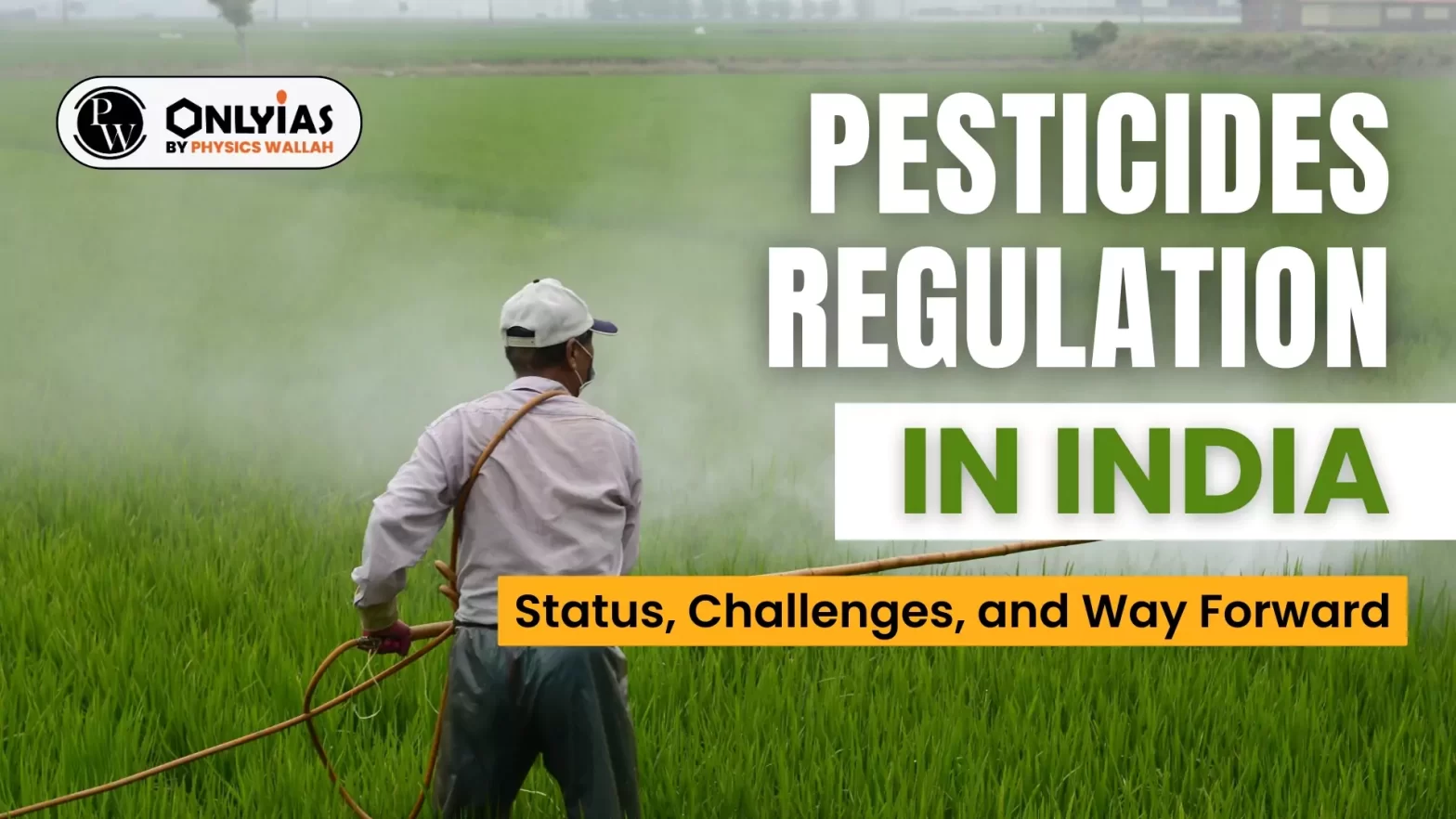

 States Consuming Most Pesticides: Maharashtra has consumed the most chemical pesticides in India in the past five years, followed by Uttar Pradesh, Punjab and Haryana.
States Consuming Most Pesticides: Maharashtra has consumed the most chemical pesticides in India in the past five years, followed by Uttar Pradesh, Punjab and Haryana. The Codex Alimentarius is a collection of internationally recognized standards, codes of practice, guidelines, and other recommendations published by the Food and Agriculture Organization relating to food, its production, labeling, and safety.
The Codex Alimentarius is a collection of internationally recognized standards, codes of practice, guidelines, and other recommendations published by the Food and Agriculture Organization relating to food, its production, labeling, and safety.